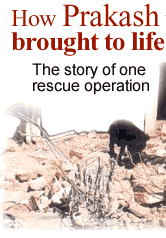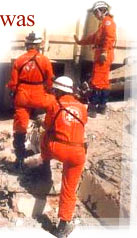The Rediff Special/ Ramesh Menon


Numerous teams of experts and specialists from various parts of the world are currently battling to rescue survivors buried under rubble in Bhuj and Ahmedabad. Roving Editor Ramesh Menon provides a blow by blow account of one such rescue mission by the Swiss disaster team.
In earthquake-devastated Bhuj, miracles can happen. Like this one:
Urs Amiet, leader of the Swiss disaster team, is told that a feeble voice had been heard from under the debris of a four-storey building.
The piece of information electrifies him and his team into action. They are in Ahmedabad. The
survivor is in Bhuj, over 420 kilometres away.
The building, he is told, is in Shivnagar in the heart of Bhuj. Within minutes, he and his 18 member-team are airborne on a special flight for Bhuj.
January 28. 2022 hours
The plane lands in Bhuj.
Not a minute is wasted.
Every second matters.
By 2050, the team, dressed in their bright orange uniforms, are at the site with their
equipment.
The team has a meeting to work out a strategy. The only information they have is that a voice was heard there. And the likely place from where it was heard.
In the next 14 minutes, they chalk out a strategy.
At 2104 they begin digging.
"It was amazing to see their reaction time. There was such a short gap between planning and
execution. Even before the locals around the crashed building knew what was happening, they had
started digging," says Kartikeyan, a ham operator from Hyderabad who witnessed the entire
operation.
It was pitch dark. There is no electricity in Bhuj. But the area where the Swiss team is working
is brightly illuminated. They had petrol generators providing power for their huge lights that
were erected on seven feet poles. When the lights came on, it seemed like daylight.
Amiet and his team had zeroed on the likely spot from where the sound came. To an onlooker, it
looked like an impossible task.
The army had been working at this building and could not figure out how to get to the survivor without hurting him.
Four floors had come down like four loaves of bread put together.
But when you work in a disaster relief team, nothing seems impossible. That is the spirit which
guides and inspires them.
On top of the rubble, which was the roof of the fourth floor, was a 1,000 litre tank with water in it. It sat precariously on the caved roof of the fourth floor. It had to be emptied as its weight would have made the tank cave in while the rescue operation was on.
Breaking it would flood the area and possibly choke the survivor to death. So the water has to be pumped out. No one had to run around to find a pump. The team had it on hand and within minutes, the tank was empty. The team members have all gone through army training, some are full time officers in the Swiss army. Others are professionals in various areas. Some are hardcore disaster relief experts who do nothing else.
The team had all the imaginable tools required for such an operation.
There are no loose ends, no flaws. It is not that they are perfect, it is just that nothing would be allowed to go wrong. At work, the only goal is to get survivors out alive. And without a scratch.
Using hydraulic rigs the team drills a hole big enough for four men to get in. As they dig, they
clear the debris with spades. Sometimes, they use their hands.
They could have asked the army to help, but they preferred doing it themselves.
Steel buckets are lowered for the big pieces of rubble and pulled up. Once the debris is
cleared, they dig again.
As they dig, they find various belongings. They gingerly bring it out without any damage.
Like a photoframe. It is intact.
Then there is a doll without its eyes.
So many lives have been snuffed out in the building. Over a hundred people were dead when the
operation was going on. The building housed mostly Indian Air Force personnel and their families.
Kartikeyan is very alert. He has to be. He is learning from watching the Swiss experts.
They are so systematic, so fast, so meticulous. Initially, the sound emanating from within the
debris is very, very faint. But as they dig deeper and deeper, the sound gets louder. This
gives the team more energy. They are getting closer.
Kartikeyan tries to make small conversation to keep the survivor's morale up. He gets him to
describe how he is lying down to assess his position and transmit it to the Swiss team. Every
bit of information is dealt with respect.
At one point, the survivor wonders why he has been lying there for so long and why no one is
helping clear the rubble. He said: "Get me out. I need to get back to work." For a moment,
Kartikeyan wonders why work is so important. Sometimes, survivors get disoriented lying in such
a condition and fighting negative thoughts.
Kartikeyan understands and says he can go to work as soon as they can pull him out.
The Swiss team constantly tells Kartikeyan to say things that will strengthen the survivor's resolve to stay alive. Many survivors die not because of the disaster, but because they lose the will to fight back.
Kartikeyan lies.
He tells the survivor that his family is waiting for him. Other than his brother, everyone in
his 11-member family is dead.
As the Swiss team digs, aftershocks hit the area. The team does not stop work for a second.
The exact location in which the survivor is lying has yet to be identified. The team has been
digging for more than seven or eight hours. No one looks at their watches.
Suddenly, they stop drilling. The onlookers think they have given up. But it has been
stopped only because they have figured they are somewhere close to him.
They drill a tiny hole in the concrete and lower down a thin stick. Attached to it is a camera.
One team member gets out his laptop and looks at what the camera sees. He sees only rubble. All angles are explored. But it is rubble, rubble and more rubble. There is no survivor in sight.
Then, they drill a hole elsewhere and put a small tube through it and ask the survivor if he
wants water. They gently send water through the tube to assess where the survivor is. They do not know if the survivor can actually get the water sent to his parched lips. But they keep trying till he says he managed to drink some water.
Now, they know where his head is by the measurement of the tube.
Then, they figure out how his body must be lying.
As they explore further by digging slowly, but calculatedly, they find a fridge. If they cut
through the fridge, they could get some crucial space. But they do not do it as a team
member, who has specialised in poisonous gases, cries halt. Cutting the fridge would be fatal.
Its compressor would release poisonous ammonia gas.
The Swiss team has every imaginable expert in the squad. All of them are hands on and do all the manual work. There is complete dignity of labour.
Also at work, clearing the rubble, is a structural engineer who watches every move clinically.
He ensures that no further collapse of the structure takes place.
India has a lot to learn in terms of disaster relief and management. Just sending columns of
soldiers trained to fight an enemy to disaster areas is obviously not the answer. The troops are just not trained or equipped for such an operation.
Getting survivors out of an earthquake-ravaged area is a very specialised job. India has no
such team. After seeing the Swiss and other foreign disaster experts at work, the Gujarat
government thinks it should get such a team.
Suddenly, the survivor can be seen lying on his back. He is conscious. The team notices his wife lying about two feet away. She has in fact touched his palm. Maybe just to connect with him before the life went out of her.
He did not know she was lying dead so close to him.
A doctor on the team gets in carefully to give the survivor anaesthesia.
It is necessary. Once he is out, he must not die of shock seeing the devastation. And the truth that his wife, children, parents and others are no more.
Gently, they lift his body to allow belts to go around him. With the help of buckles and a rope
they haul him to safety.
And to another life.
January 29. 0932 hours.
The entire operation has taken 12 hours, 28 minutes.
Prakash is rushed to hospital. His life will live up to his name which in Hindi and Gujarati means light.
Design: Dominic Xavier
The Complete Coverage | List of earthquake sites
Back to top